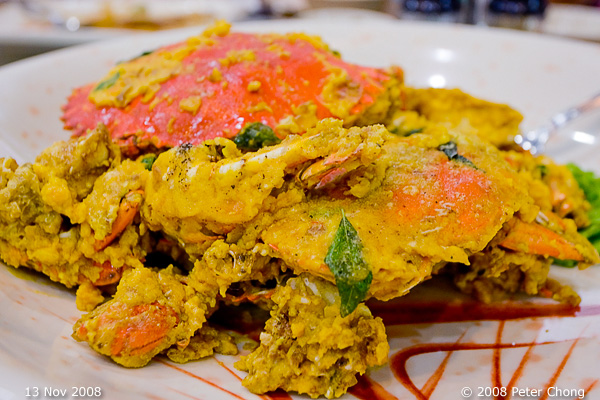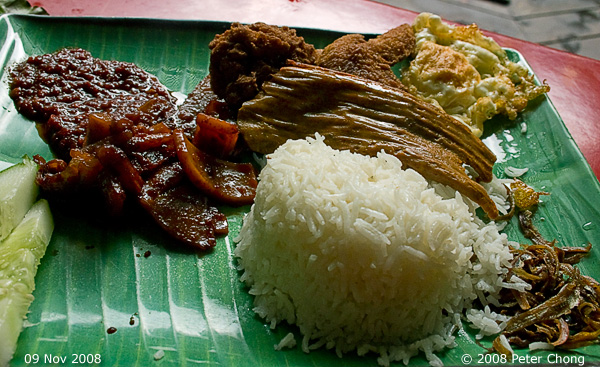organized by Champagne and Mien3 for ieatersWhen I got the notice for the makan session, I was intrigued by the Deep Sea Giant Grouper...and to have an entire restaurant devoted to this fish...interesting! Some research led me to discover that the giant grouper (Epinephelus lanceolatus) is the largest bony fish in the world, and can grow up to 2.7m and 600kg. It is found in the Austalian and Indo-Pacific waters.

The fish shown above is about 0.8m in length.
The fish is born female, and as they grow, they can turn into male if they reach about 1m in length. Each male usually have a dozen or so smaller females in his harem. From diving reports, the fish is known to be very inquisitive, and will come close to a diver to have a better look.
But according to Yuan Wei's owner - Heng Heng, "the giant Garoupa grows in deep sea, it has for a long time kept away from polluted areas. As it contains rich vitamins and low fat, it is considered the most healthy diet for people of the modern time. According to medical reports, deep-sea giant Garoupa contains rich protein, vitamin D an calcium, which are very beneficial for curbing bloot clot, anti-cancer and brain development. Its skin contains much collagen, which enables ladies to maintain beauty and skin care if taking it regularly." (Taken from his
website)
Rather interestingly, after this discourse about the purity of the fish because of deep sea living...Heng also told us that the fish were actually farmed in Malaysia and Indonesia. See this youtube video on
harvesting the giant grouper. He only uses live fish, ranging from 15 to 30kg, as it is most tender at this size.
Based on the health giving claims, a rather large group of ieaters went to improve our health.
We started with the deep fried enoki mushrooms and bean curd with salt and pepper.

As a starter, this is perfect. The mushrooms were coated with a thin, crispy batter, and the insides remained juicy and full of flavour. Delicious.
Braised fish livers with spring onion in special sauce.

The taste was like a cross between foie gras and pork liver. The texture and consistency was more akin to the duck brethen but the mouthfeel and taste was similar to pork liver without the porky smell. Quite interesting.
Next up was a dish of stir fried fish lips...this is a huge fish. The live sample still swimming in the aquarium in the shop was a small example, and Heng Heng said it weighed about 15kg...it had lips as large as a human child of perhaps 6 or 7. The one we ate must be larger...it was enough to feed almost 18 pax.

The taste of the lips were not different from those found in fish head curry or fish head soup made from grouper of smaller size. But as the fish was larger, the lips had a firmer consistency, and more gummy and borders on being chewy. The sauce was an intriguing taste of salt, and savoury.
The vegetables were next with a serving of mixed mushrooms and vegetarian beancurd.

Very fragrant dish...the mix of 4 or 5 different mushrooms - more fresh enoki, straw, button, and traditional chinese dried mushrooms created good flavour. The braising liquid was nice balances well with the soft tofu.
The fish head and belly was braised and served as the next course.

I rather like the bite sized chunks of fish head...some with gooey parts, some just plain flesh, some with bone, others without. The sauce was similar to the other braised dish we already had - the livers and also tasted similar to the sauce in the mixed mushrooms. Was the chef using the same stock and shortening?
The house speciality beef was next.

The beef was not the super tender variety you find in Prince or other places where the meat is smooth, tender, juicy. This was a rather rougher cut...but full of flavour, and it was tenderised by hammering it with a tenderiser to break up the tough fibres. It was soft and on the palate felt tender, though if one tries, one could discern the sinews. The sauce was a kind of black pepper sauce stir fried with bits of black pepper and capsicum and onions. Very punchy.
Brocoli and fish stomach was next.

The stomach was smothered with a thick sauce, which mildly reminds me of a taste that points to oyster sauce as a base. The bite sized stomach was chewy, and rather tough. The consistency of the stomach was similar to that of boiled pig stomach as used in a soup, but was almost completely without smell. The broccoli was lightly blanched, and mildly cooked...it provided a crunch, and complemented nicely with the stomach.
We then had Fried Fish Hor Fun...

At first look, the hor fun looked like it was Ipoh hor fun, which is boiled/steamed instead of fried. But a quick taste of the pale looking hor fun confirmed that it was indeed fried. It had quite good wok hei, though the pale complexion suggested otherwise, this hor fun spent some time in the ferocious fire of the wok. Unusual. The fish slices that were fried with the hor fun was rather firm - confirming that this was indeed a large fish, but was quite tasty, and hints of sweetness. Heng later describes the fish meat as a kind of "suspension", referring to the springiness of the meat and perhaps the firmness.
And the
piece de résistance. A surprise, actually as the restaurant specialises in Giant Grouper, but the salt egg yolk crab is something to be savour.

First glance would be deceiving to a crab connoisseurs...the crab was rather small. But one taste would convert most. The salted egg yolk provided a generous covering for the crab, like a mother smothering a child, as if to protect it. Ijeff conservatively estimated at least 10 salted eggs were sacrificed for this dish. Methinks he is very conservative. The taste was marvellous! The crab meat was moist, juicy and very sweet. And the salted egg yolk sauce, if I may call the paste like stuff completely covering the crab a sauce, was to die for. Complex in taste, it was rich, creamy, savoury, fragrant and had a great mouthfeel. Everybody loved it.
When all was almost done, Edward, being a growing teenager...was still hungry, and we ordered a plate of special (not on the menu) salted egg fried rice.

Each strand of rice stood on its own, coated in egg yolk...great taste. I would have imagined this dish to be salty, but it was not. A great way to finish off with extra carbohydrates (what with steamed rice during the meal and the hor fun if anyone needed more carbs. But none of us were on an Atkins diet, so we whacked).
A plate of mixed fruits signified the conclusion of a great makan session. Great company, good food. I wish I had taken up Mien's suggestion to BYO some wines...perhaps a nice bottle of Cloudy Bay Sauvignon Blanc and a slightly acidic champagne like Pol Roger might do well with this dinner.

A view of the kitchen. See the 3 or 4 huge power fire stoves used for cooking.
Yuan Wei Deep Sea (Giant Grouper) Porridge and Steamboat
1001 Serangoon Road Singapore 328165
Time: 1700 - 0400 (note opening hours...no lunch, and open almost all night)
Owner: Heng Heng
Telephone / Fax: 62977255 Handphone: 91963354
Photo notes: the restaurant was rather dark, lighted with flourescent lighting. All shots were taken handheld, some were blurred by handshake...shooting at ISO800 and at 1/8s at 40mm without IS is not easy. White balance adjusted in PS using reference 50% grey layer using the WB by numbers technique.





















































